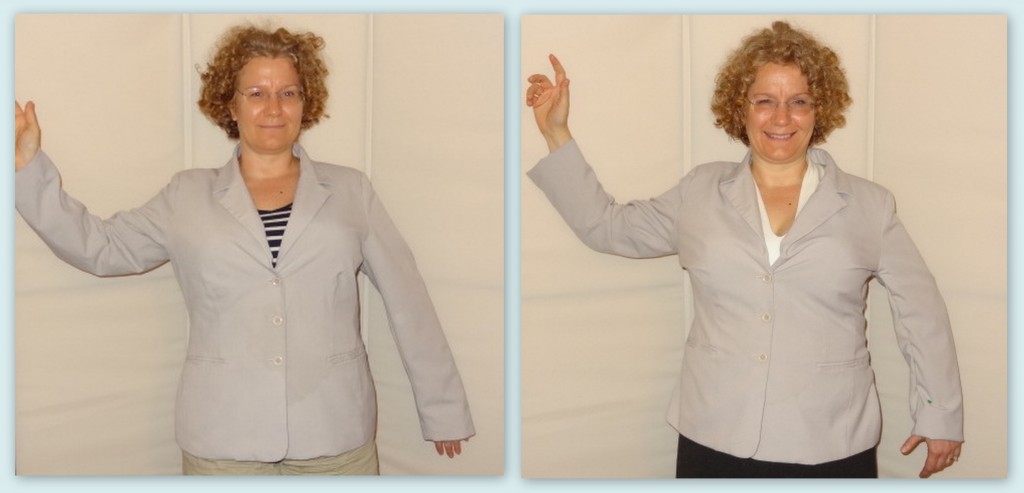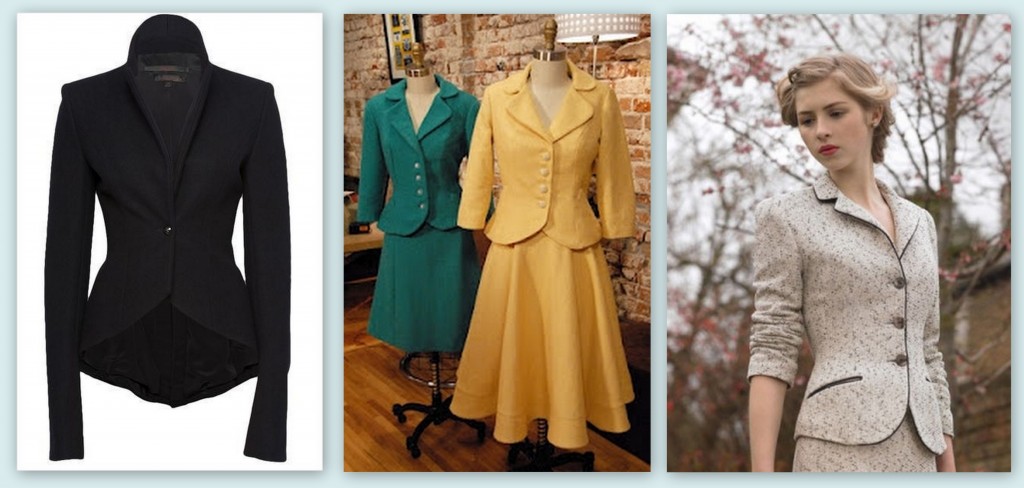After surmising about it to you yet again, I decided to put my money and time where my mouth is and actually explore the practicality of buying and altering a blazer that fits the bust but is too big everywhere else. I found an XL Target Merona blazer at a Salvation Army thrift store for $6 and took it to my new favorite tailor, Elena Priedane of the Tailor Shop in Astoria. I chose to visit Elena instead of Ros Tailoring because she does not make custom clothing, so my experience with her would be more representative of what most women with large busts can expect.
Elena uses three critera for deciding on alterations:
- what will make her client look better;
- whether she can work with the original design; and
- the time and skill involved–in other words, whether the alterations can be made for a price her client can afford.
(Pockets and lining are a big factor in the price of altering a jacket because they take more time to reverse engineer to construct from scratch. Also, although Elena has good news for a woman who wears a size 8 skirt and a size 14 top because of bust size–it is possible to alter a jacket so that the waist is very close to a size 8–the need to adjust armholes makes this more challenging (and therefore more expensive) than it is to alter a jacket for a woman with size 14 hips and a size 8 top.)

Using the above criteria, Elena told me that for $120, she would
- shorten and taper the sleeves of my blazer;
- narrow the armhole by taking it in under the arm and above the chest; and
- take it in at the waist.
I think that’s a reasonable price for those changes, but here are the three criteria I used to decide against them:
1. The quality of the original jacket
The fabric didn’t have a nice drape or hand. Although it feels like cotton, it’s actually 61% polyester, 35% rayon, and 4% spandex, and the lining is 100% polyester. It looks rumpled fresh off the hanger. A heavier fabric would look smoother. When a woman wearing something amazing tells me that she bought it at Target, I’m always surprised. Unfortunately, I don’t think anyone would be surprised if this jacket came from K-Mart. In the future, I will look for silk and wool blends or an unlined cotton duck.
2. The style of the original jacket
It’s simply too utilitarian. It makes me look like I should be in the trading pit at the New York Stock Exchange. We always think we’ll buy anything we can find that will fasten at the bust, but that’s never the case. It has to be our style, and boxy isn’t my style. You can see the jacket style I gravitate towards below (they’re from my Clothing Wish List for D Cups and Up board on Pinterest).
Also, although the color seems practical, in the future I will be combing the thrift store racks for deeper neutrals or more vibrant accent colors.
 3. The effect of the alterations
In this case, the alterations would not make a dramatic enough change. As I learned from Elena, the purpose of alterations are to change the fit, not the style. So if the jacket didn’t originate with princess seams, a tailor can’t add them (unless you want to pay 100X more than the cost of a new jacket). Sadly, it’s the same with peplums. I had visions of Elena creating a peplum over the pockets to turn my jacket into something like this denim Theory jacket or one of the blazers below, but it was not to be.
 Elena was sympathetic to my disappointment. She suggested changing the buttons or using colored thread or adding a brooch to spice things up–all good suggestions worth considering with future jackets.
I’m now on a mission to find a high quality jacket for no more than 30 cents to the dollar of the original price in a style that I love. If I can forego pockets and lining to make the alterations less expensive, so much the better.
Have you found a jacket worth altering?


Jackets give me headaches. 🙂 It just seems that I have a harder and harder time with them. At the moment I don’t have a single nice suit outfit (something I could definitely use!). I kept thinking about trying Pepperberry’s jacket here: http://www.bravissimo.com/pepperberry/products/sale/coats/jackets/pinstripe-jacket/grey-stripe/ma01gs/?show=16&sort=1&level=3 but even on sale the price, once you convert it into Reais was a lot (now they’re sold out in my size anyways). Their new classic blazer actually doesn’t look like it even fits their model that well in the waist: http://www.bravissimo.com/pepperberry/products/sale/coats/jackets/classic-blazer/black/ap06bl/?show=16&sort=1&level=3 and the buttons on it are just strange. 🙁
I picked up a used BiuBiu Paris Noir: http://biubiu.pl/en/paris-noir.html about a month ago (still waiting on the post to actually bring it, though!) so my hope is that it’ll cover most work needs. However, a well-fitted business suit can really make you look much more professional and that’s something that’s certainly still missing from my wardrobe! 🙁
I have altered a jacket once. I purchased it at old navy. The fit in the shoulders and arms were fine, but the waist was all wrong. I ended up getting the jacket for around $20 and then spend around $20-25 to take in and raise the waist.
It looked really cute. Until I lost weight and it was too big. Then I gave it to my sister and it fits her great right now.
I was thinking about getting a blazer at Nordstrom altered once, and it was going to cost around $120 to take in and elevate the waist adjust the sleeves and I don’t remember what else. The blazer fit great in the shoulders and was all wrong elsewhere.
One tip, head over to Nordstrom Rack. You can probably find a great jacket on clearance. If you sign up for the rewards program (no credit card needed, you can link your debit card, and it is free) you get $100 in free alterations per year (maybe more if you sign up at the right time). And you can get alterations at Nordstrom Rack or Nordstrom.
So my plan is to get some alterations once I hit my goal weight! 😀 $100 would put a very good dent in getting any jacket alterations.